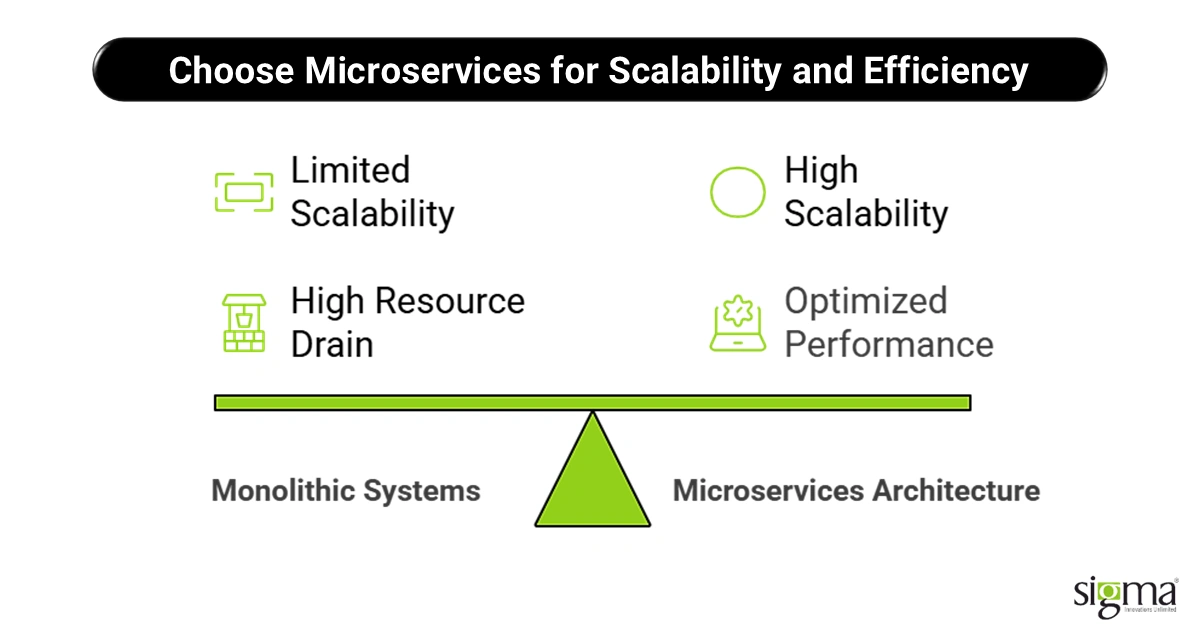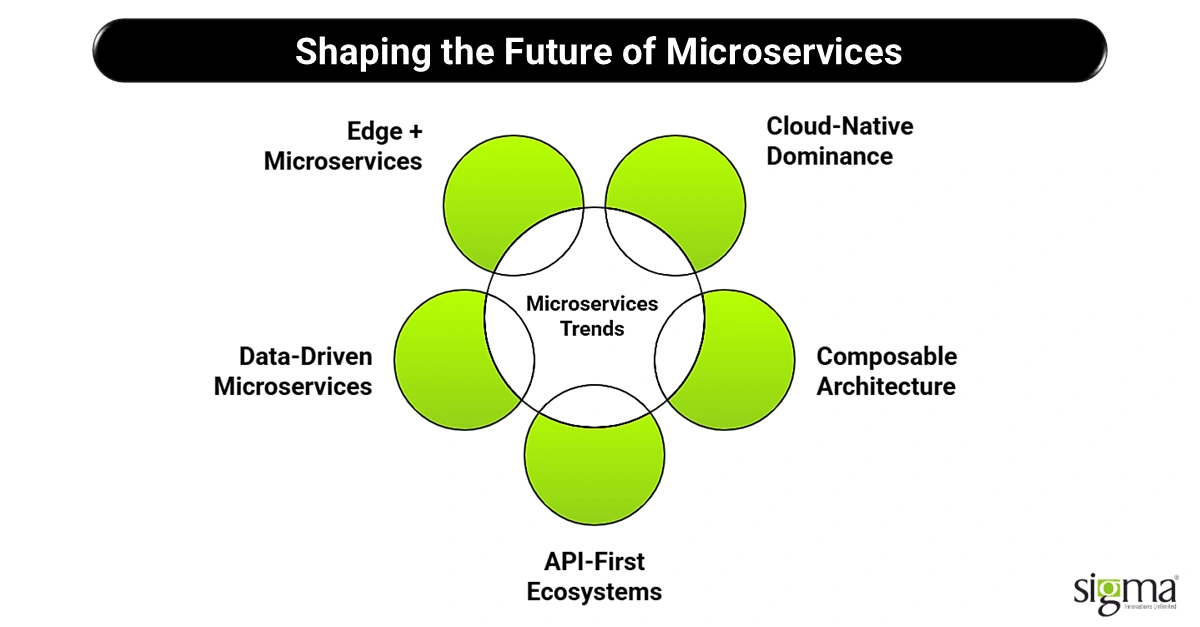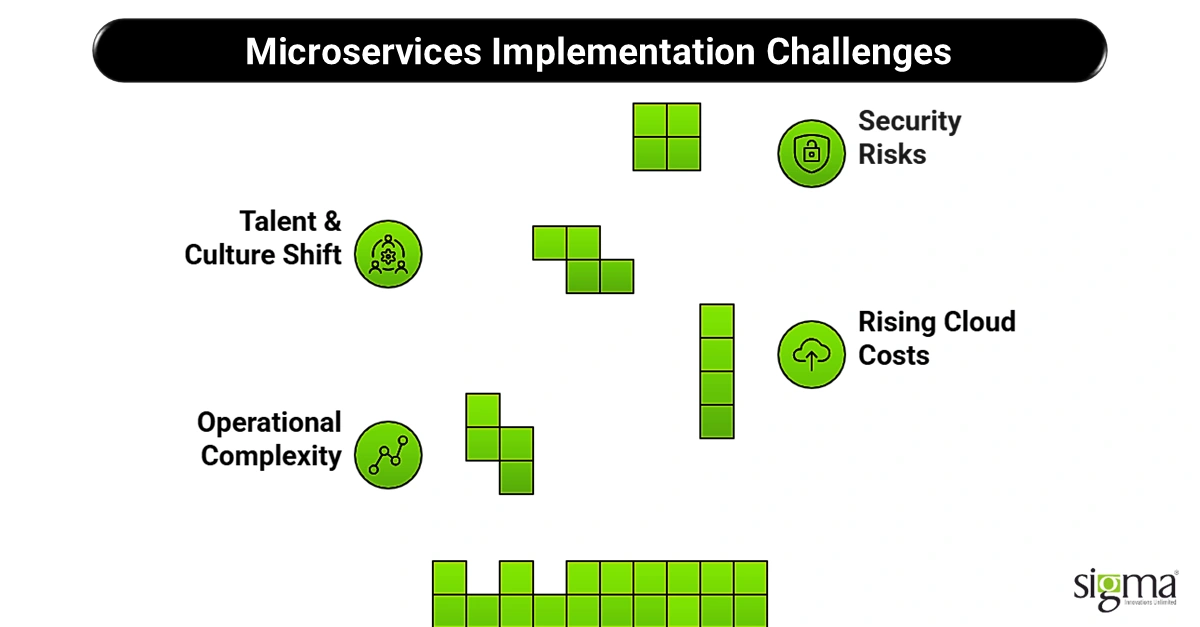Why the C-Suite Can’t Ignore Microservices-Based App Development Services

Key Takeaways:
- Think of microservices like a fleet of speedboats, not a single ship: Agile, modular services let your business pivot fast without sinking the whole operation.
- Innovation without fear: Launch new features or experiment with BI, AI, and UX modules independently—like testing ingredients before baking the whole cake.
- Scale only what you need: Microservices let you grow specific components—payments, analytics, inventory—like turning up a single faucet instead of flooding the house.
- Risk isolation is your safety net: A failure in one microservice doesn’t topple the entire system—like a single seat in a stadium giving way without collapsing the whole structure.
- Future-proof your digital engine: Move from “buying software” to “engineering platforms” that evolve with your business, ensuring legacy systems don’t steer your ship.
The digital business landscape has never been more demanding. Markets are shifting faster than ever, customer expectations are sky-high, and competition is fierce across industries—from fintech and retail to SaaS and eCommerce. For the C-Suite, this isn’t just about keeping pace; it’s about building organizations that are resilient, scalable, and ready for continuous change.
That’s where microservices app development comes in. Too often, executives see it as a “technical buzzword” meant only for engineering teams. In reality, microservices architecture is a strategic lever for growth, agility, and competitive edge. It reshapes how businesses launch new digital products, respond to market shifts, and future-proof their technology investments.
Here’s the truth: ignoring microservices today is like ignoring cloud a decade ago—companies that delayed adoption are now playing catch-up, while early movers dominate the market. With the rise of cloud-native microservices, organizations can accelerate innovation, scale applications on demand, and unlock new revenue streams with far less risk.
For decision-makers in the C-Suite, this is no longer an IT decision—it’s a boardroom priority. Whether you’re leading digital transformation in banking, building real-time payment apps with microservices, or scaling SaaS platforms, your technology choices today will decide tomorrow’s market leaders.
At Sigma Infosolutions, we see microservices solutions and custom development services not as “IT projects” but as business enablers. They’re the foundation for scalable app development services that align directly with your C-Suite technology strategy.
The C-Suite Agenda: Business Priorities Driving Technology Choices
The C-Suite faces a balancing act that’s tougher than ever. Growth is still the top line on the agenda, but getting there requires launching products faster, adapting to unpredictable markets, and scaling operations without losing agility. Every boardroom conversation circles back to one question: how can technology accelerate business goals instead of slowing them down?

At the same time, rising cloud and infrastructure costs are forcing CFOs and CTOs to rethink spending. Cost efficiency isn’t about slashing budgets; it’s about investing in app development services that scale smartly. That means moving away from monolithic systems that drain resources and leaning into microservices architecture that optimizes performance and costs.
Meanwhile, CEOs and CMOs are under pressure to push innovation—delivering digital experiences that aren’t just functional, but differentiated and customer-centric. And let’s not forget the ever-present risks: regulatory compliance, data security, and the need for resilient systems that guarantee business continuity.
This is where microservices app development becomes the engine for aligning technology with boardroom priorities. With microservices solutions and custom development services, organizations can strike the perfect balance—speed, efficiency, innovation, and risk management—all built into one scalable framework.
From Monolith to Microservices: A Strategic Shift, Not Just a Technical One
For years, monolithic systems powered enterprise applications. But in today’s digital-first economy, they’re starting to look more like anchors than engines. Rigid architectures slow down innovation, release cycles stretch for months, and scaling becomes a bottleneck that eats up both time and budget. For the C-Suite, that translates into missed opportunities, sluggish market responses, and rising operational costs.
This is why forward-looking enterprises are making the strategic shift to microservices app development. Unlike monolithic systems, microservices architecture breaks applications into independent, modular services that can be built, deployed, and scaled separately. That means faster product launches, fewer disruptions, and a level of agility that traditional systems simply can’t match.
The beauty lies in its design. If one service fails, it doesn’t bring down the entire system—fault isolation ensures continuity. Need to handle a sudden traffic spike in one function, like payments or search? Modular scaling lets you ramp up just that piece without overinvesting in the entire app. These are not just technical benefits—they’re strategic levers that drive resilience and competitiveness.
Here’s the thought leadership angle: microservices is not just architecture—it’s a philosophy of agility and resilience. It redefines how businesses think about technology—moving from a static “system of record” mindset to a dynamic “system of innovation” approach.
At Sigma Infosolutions, we help organizations embrace this shift with tailored microservices solutions and custom development services, ensuring technology is not a barrier but a business enabler.
Also Read: Old Meets New: Legacy system modernization with a .NET Makeover
Microservices Trends the C-Suite Must Know
The pace of change in digital technology is accelerating, and microservices app development is at the heart of it. The global market for microservices architecture is projected to grow significantly, climbing from $4.2 billion in 2024 to an estimated $13.1 billion by 2033.
For businesses, that means the question isn’t if to embrace microservices, but when. The sooner you jump on the bandwagon, the faster you can unlock growth, efficiency, and resilience. For the C-Suite, understanding these trends isn’t about getting lost in technical jargon—it’s about recognizing how microservices architecture directly fuels business outcomes. Here are five trends shaping the future:

- Cloud-Native Dominance: Enterprises are doubling down on cloud-native microservices built on AWS, Azure, and GCP. These platforms provide scalability, flexibility, and cost optimization at a level legacy systems simply can’t deliver. For CFOs, this means smarter infrastructure spend; for CTOs, it means faster innovation cycles.
- Composable Architecture: The future of digital products is plug-and-play. With microservices solutions, businesses can build composable architectures where individual services—payments, analytics, or user authentication—are assembled like Lego blocks. This accelerates time-to-market and empowers product teams to innovate independently.
- API-First Ecosystems: Partnerships are becoming the backbone of digital growth. An API-first strategy, powered by scalable app development services, makes it easier to integrate with fintech players, eCommerce marketplaces, and SaaS ecosystems. For C-Suite leaders, this translates into new revenue channels without re-architecting the core.
- Data-Driven Microservices: With the rise of BI, AI, and predictive analytics, custom development services are embedding intelligence directly into microservices. From personalized customer journeys to real-time fraud detection, data-driven microservices unlock both efficiency and differentiation.
- Edge + Microservices: In industries like fintech, eCommerce, and IoT, milliseconds matter. By pairing edge computing with microservices, businesses reduce latency, deliver seamless customer experiences, and ensure continuity even when networks are stressed. Think real-time payment apps with microservices or scalable SaaS apps using microservices as proof points.
These aren’t just tech buzzwords. They’re the blueprint for how digital enterprises will scale, compete, and win. Leaders who embrace them early will set the pace; those who delay risk falling behind in both innovation and market relevance.
Business Value for the C-Suite: Why It Can’t Be Ignored
For executives, technology decisions boil down to one thing: business value. Microservices app development delivers on this front by directly supporting boardroom priorities—growth, efficiency, innovation, and resilience. Here’s how:

- Speed to Market: In a hyper-competitive world, being first often means being ahead. With microservices architecture, teams can launch new features independently, without waiting for the entire application to be re-deployed. That means weeks—not months—to bring new ideas to market.
- Scalability on Demand: Not every part of your business needs to scale equally. Microservices solutions let you scale individual components—like payments during holiday peaks—without overspending on infrastructure. The result? Lower costs and smarter use of cloud resources.
- Risk Reduction: One failure shouldn’t cripple your business. With microservices, if a single service fails, it’s isolated from the rest of the system. That means stronger uptime, less disruption, and more resilience in customer-facing applications.
- Innovation at Scale: Want to test a new feature, like AI-driven personalization? With custom development services powered by microservices, experimentation becomes low-risk. You can trial new capabilities without jeopardizing core systems.
- Customer Experience: At the end of the day, what the customer sees matters most. Microservices help deliver seamless, consistent performance across channels—from mobile to web to IoT devices—ensuring engagement and loyalty.
Think of monolithic systems like a single giant ship. Powerful, but slow to maneuver. Microservices, on the other hand, are like a fleet of speedboats—fast, agile, and able to navigate change without losing momentum. For the C-Suite, that flexibility can make the difference between leading an industry and lagging behind.
At Sigma Infosolutions, our microservices-based app development services, as demonstrated in our case study on scaling loan processing, are designed to deliver exactly these outcomes—future-ready, scalable, and tailored to your unique business needs.
Microservices in Action: Use Cases Across Industries
Understanding the business benefits of microservices is easier when you see them in action. Across industries, leaders are adopting microservices app development to power agility, resilience, and innovation.
- eCommerce: Think about holiday sales or flash deals when traffic spikes overnight. With microservices architecture, retailers can scale inventory management or checkout services independently, without stressing the entire system. Personalized shopping journeys—powered by AI and analytics—can also be delivered as microservices, creating tailored experiences that boost conversions.
- Fintech: Speed and security define modern finance. Microservices power real-time payment apps, fraud detection systems, and regulatory adaptability. For example, a fraud detection microservice can analyze transactions instantly without slowing down the payment process. Regulators change the rules? A single compliance microservice can be updated without disrupting the entire platform.
- Custom Product Development: Companies today need modular innovations that combine BI, AI, Salesforce, and next-gen UX. With custom development services, microservices enable exactly that—independent modules that plug seamlessly into existing ecosystems. This flexibility allows experimentation without massive re-architecture.
At Sigma Infosolutions, we’ve seen these benefits firsthand. Our microservices solutions span across Adobe Commerce, Shopify, WooCommerce, Salesforce, AWS Cloud, and more. Whether it’s helping an eCommerce leader handle Black Friday traffic, enabling a fintech firm to build real-time payment apps with microservices, or delivering scalable SaaS apps using microservices, our expertise ensures that technology becomes a true growth enabler.
For the C-Suite, the message is simple: microservices aren’t just for IT—they’re a foundation for business innovation across industries.
Also Read: Bid Goodbye to Technical Debt with the Best Technology Development Services
The Challenges: What the C-Suite Must Anticipate
As powerful as microservices app development is, the journey isn’t without hurdles. For the C-Suite, success depends not only on embracing microservices architecture but also on anticipating the roadblocks that come with it.

- Operational Complexity: Microservices replace a single, monolithic system with dozens—or even hundreds—of independent services. While this boosts agility, it also increases operational complexity. Without the right governance, monitoring, and orchestration tools, managing distributed systems can quickly overwhelm IT teams.
- Rising Cloud Costs: Cloud-native microservices bring flexibility, but if not architected wisely, they can balloon infrastructure costs. C-Suite leaders must ensure a strategy that optimizes cloud usage with auto-scaling, right-sizing, and cost monitoring to prevent spending from spiraling.
- Talent & Culture Shift: Microservices aren’t just a technology shift; they demand a mindset shift. Success requires DevOps practices, automation, and cloud-native thinking. This means retraining existing teams or hiring new talent that can work in a culture of continuous delivery and cross-functional collaboration.
- Security Risks: More endpoints mean more potential vulnerabilities. Each microservice introduces its own security considerations, from APIs to data flows. The C-Suite must prioritize enterprise-grade security frameworks, compliance checks, and continuous monitoring to safeguard both systems and customer trust.
In short, microservices offer immense business benefits, but they’re not a silver bullet. With the right strategy, custom development services, and trusted partners like Sigma Infosolutions, these challenges become manageable—and the payoff is long-term agility, scalability, and resilience.
Custom Development + Microservices: The Competitive Edge
To thrive in the digital economy, you need more than off-the-shelf software. Custom microservices provide the agility and flexibility needed to support unique business models, giving organizations a true competitive edge. For the C-Suite, this isn’t about technology for technology’s sake—it’s about enabling innovation, faster time-to-market, and sustainable growth.
With microservices app development, companies can engineer modular solutions tailored to their exact needs. Need predictive analytics integrated with a customer-facing platform? Or a Salesforce module that adapts to changing regulatory demands? Custom development services layered on a microservices architecture make this possible without disrupting other core systems.
At Sigma Infosolutions, we bring this vision to life. Our team combines expertise in BI, AI, Salesforce, UX design, and eCommerce platforms—including Adobe Commerce, Shopify, WooCommerce, and BigCommerce—to deliver microservices solutions that are fully customized. This approach ensures that your technology investments are not only scalable but also aligned with your strategic business goals.
Here’s the thought leadership angle: C-Suite leaders must shift their mindset from simply “buying software” to “engineering platforms.” Microservices combined with custom development transforms IT from a cost center into a strategic growth engine, enabling organizations to innovate continuously, respond to market changes faster, and differentiate in crowded markets.
For executives, this is more than a technical strategy—it’s a blueprint for sustainable, competitive advantage in the digital age.
Roadmap for the C-Suite: Moving Toward Microservices
Transitioning to microservices app development doesn’t happen overnight. For C-Suite leaders, a clear roadmap ensures technology investments drive real business outcomes.
1. Audit Legacy Systems – Start by assessing existing monolithic applications. Identify which systems can be modernized or replaced to unlock agility and scalability.
2. Prioritize Use Cases – Focus on areas that directly impact growth, efficiency, or customer experience. High-value services—like payments, analytics, or inventory—should be first in line for microservices solutions.
3. Adopt Cloud-Native DevOps Practices – Embrace automation, continuous delivery, and cloud-native frameworks to maximize speed, resilience, and cost efficiency.
4. Choose the Right Partner – Success depends on expertise. Sigma Infosolutions delivers custom development services and microservices-based app development services across eCommerce, Fintech, and enterprise platforms, helping organizations execute this transformation smoothly and confidently.
The Future Belongs to Microservices
The future of enterprise technology belongs to organizations that embrace microservices app development. By adopting a microservices architecture, companies unlock agility, accelerate innovation, optimize costs, and reduce operational risk—all while delivering seamless, scalable experiences to their customers.
For the C-Suite, the message is clear: lead with vision. Don’t let legacy systems define your future. Prioritize microservices solutions and custom development services that align technology strategy with boardroom goals.
At Sigma Infosolutions, we partner with enterprises across eCommerce, Fintech, and enterprise applications to design and implement microservices-based app development. From cloud-native microservices to tailored custom development solutions, we help organizations reimagine their digital future—ensuring technology is a driver of growth, resilience, and competitive advantage.
Your next move as a decision-maker: embrace microservices today, and position your organization to lead in the digital economy tomorrow.